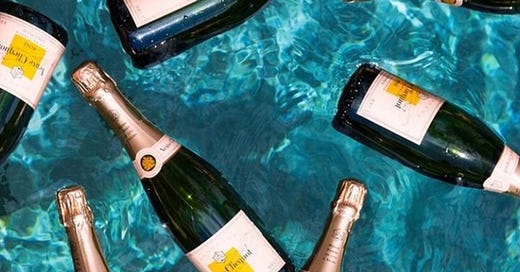2024 did not get off to a good start in Champagne. Sales figures have continued to plummet by double digits and the viticultural year got off to a complicated start. Both events have stayed relatively under the radar in the mainstream press, though Wine-Searcher has published 2 articles on the sales slumps (penned by yours truly) and in today’s Sunday overview, Oliver Styles mentioned last week’s hail storm.
On Tuesday the yearly Champagne key figure report was released, as well as the provisional sales figures for April 2024. It is by now well known that champagne sales collapsed compared to 2023, but the report is a very useful piece of data to see what drives the sales (or lack thereof). And this is what I looked at for Wine-Searcher earlier this week. The big take-away from the report is the hollowing out of the non-vintage category in just about all markets, and the increasing demand for Extra Brut/ Brut Zero cuvees as well as the Cuvees Prestige category. While I stuck to the data in my Wine-Searcher piece, it pays to dissect this information, and add some interpretation.
The non-vintage (BSA) category is Champagne’s bread and butter. Remember almost 90% of the land is owned by grape growers – officially there are 16,200 grape growers – as in ‘déclarant de récolte’, which literally means people who have filled in a harvest declaration – but there are only 4,200 champagne producers, as in entities who actually make and sell champagne. This means that most of the growers sell their grapes, either to the cooperatives or to the well-known champagne houses. The key figure report states that there are 135 cooperatives and 390 houses, which means the remaining 3675 are winegrowers, and of the 4200 producers, only 2000 export.
If one looks at the data from a different angle, in 2023, 299 million bottles left Champagne, of which 217 million (72.5%) were shipped by houses, 57 million (195) by winegrowers and 26 million were sent by cooperatives. It is thus clear that even though they only own 10% of the land, the houses are responsible for most of the champagne sales. They are thus reliant on grape contracts to fill market demand. In general, these contracts came with quality requirements, as growers needed the houses to buy their grapes. It was thus a win-win situation for everyone. However, over the last two to three decades, this delicate balance between growers and houses has slowly eroded. There are many reasons to justify why the power shifted to the growers side, but the main ones can be attributed to the law of demand and supply. In 1986, champagne sales exceed 200 million bottles for the first time, and only 13 years later, in 1999, sales had exploded to reach 327 million bottles, (+37.6%) driven undoubtedly by millennial fever. At the same time the appellation surface increased by roughly 5000 hectares (=16.7%). Needless to say, grapes became a hot commodity. Moreover, in 1998 a EU regulation on price indication forced the CIVC out of its grape price setting role, and led grape prices to surge, driven mainly by LVMH, the region’s largest player, which was determined to solidify its market position come hell or high water. As prices continued their upward spiral, grape quality began to
Keep reading with a 7-day free trial
Subscribe to Terroir Champagne to keep reading this post and get 7 days of free access to the full post archives.




